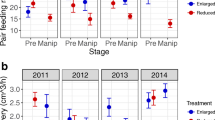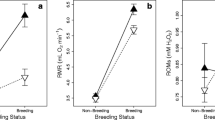Abstract
Parental investment theory predicts that parental effort should be related to the reproductive value of the current brood. This depends on both the number of young and the survival prospects of each of them. Thus parents may provide more care to larger broods either because of (1) the direct effect of brood size per se on reproductive value (the “brood size” hypothesis) or because (2) past mortality, reflected in current brood size, predicts future mortality of the brood and hence its reproductive value (the “brood success” hypothesis). Earlier studies have not attempted to distinguish between these alternatives. We tested the hypotheses in the precocial, nidifugous common goldeneye Bucephala clangula, a species with uniparental female care. Maternal effort was measured as the time spent by the female in rearing the brood. We found that brood size itself is not associated with maternal effort, but that females modify their maternal effort according to the mortality already experienced by the brood, supporting the prediction of the brood success hypothesis. We also found that brood mortality varied considerably between broods and that previous mortality predicts future mortality within broods, basic assumptions of the brood success hypothesis.
Similar content being viewed by others
Author information
Authors and Affiliations
Additional information
Received: 30 January 1996 / Accepted after revision: 27 October 1996
Rights and permissions
About this article
Cite this article
Pöysä, H., Virtanen, J. & Milonoff, M. Common goldeneyes adjust maternal effort in relation to prior brood success and not current brood size. Behav Ecol Sociobiol 40, 101–106 (1997). https://doi.org/10.1007/s002650050321
Issue Date:
DOI: https://doi.org/10.1007/s002650050321




